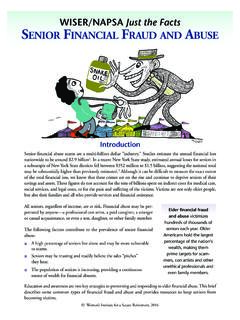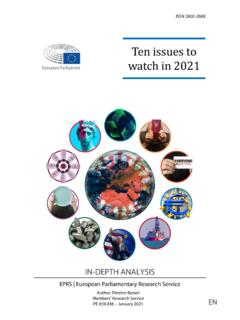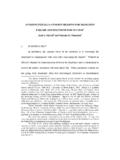Transcription of The Art of De-escalation and Conflict Resolution
1 The Art of De-escalation and Conflict ResolutionLieutenant Jeremy RomoSt. Louis County Police DepartmentAll rights reserved. This presentation or any portion thereof may not be reproduced or used in any manner whatsoever without the express written permission of the publisherObjectives Define Conflict Resolution and De-escalation . Explain the characteristics of someone that is in crisis. Describe the appropriate response to someone in crisis. List the benefits to applying Conflict Resolution and De-escalation in the workplaceWhat is Conflict Resolution ?Recognizing, defusing and controlling aggressive behavior through the use of crisis intervention techniques, communications in conjunction with an understanding of attitudes, emotions and of Conflict Resolution Increased effectiveness in the workplace Stronger support from fellow employees and clients Less complaints and law suits Reduced job related stress Increased safety in the workplaceDefinition of Behavioral CrisisAn episode of mental and/or emotional distress that is creating instability or danger and is considered disruptive by the community, friends, family or the person him/herself Adapted from the Seattle Police DepartmentCharacteristics of of one s general state of psychological healthy coping mechanisms have , impairment or Caplan.
2 MDCrisis StateA precipitating event has recently occurred and the subject s normal coping mechanisms have not worked to resolve the situationThe subject is acting and responding from an intense emotional level rather than a rational/thinking level, in response to a highly stressful situationCrisis Recognition And ResponseEmotionallyDistressedPersonMenta l IllnessMedicalConditionSubstanceUse Disorder or other Addiction IssuesSituationalStressAdapted from Nassau County, NY Police Department Career Financial Relationship 8 Common Signs of Agitation With Someone In Mental Health Crisis Raised voice High-pitched voice Rapid speech Pacing Excessive sweating Excessive hand gestures Fidgeting Shaking Balled fists Erratic movements Aggressive posture Verbally abusiveCrisis Recognition And ResponseCrisis InterventionA process to assist individuals in finding safe and productive outcomes to unsettling eventsAdapted from Police Training InstituteUniversity of Illinois10 Importance of Time in the Crisis Communication ProcessTime (passage of time)
3 Generally has a positive effect on crisis intervention Reduces anxieties and Increases rational thinkingAt the onset, everyone's anxieties are high and rational thinking is To Successful Crisis InterventionEmotional BarriersAnger, pride, depression, anxiety, frustration, disappointment, sadnessPhysical BarriersBuildings or structures, space, distance, elevation, weapon, any object that impedes progressOther Potential BarriersLanguage, Culture, Bias (overt or implicit), differences in perception or viewpoint, position, financial Body language To n e Word Choice3 Aspects of Communication55%38%7%CommunicationNon VerbalToneWords Voice - Your #1 ToolThe WAYsomething is said can be 5xmore important than Whatis of voice, demeanor& projected sincerityare more important than any single phrase that you may :Calm is just as contagious as fear or panic How to React to Someone In Mental Health CrisisConduct yourself with IntegrityMaintain Professionalismthe skill, good judgment, and polite behavior that is expected from a person who is trained to do a job well(Merriam Webster)
4 Maintain Self-ControlWhen confronted, with a difficult employee, the first step is not to control their behavior, but to control your own behaviorThe onlyaspect of a crisis situation that we have absolute control over is ourown EmotionsMaturity and RespectIf you appreciate another persons sense of dignity, self worth, curiosity, and healthy suspicion then you will never be upset by people who initially challenge your authorityDe- escalation ProcessActive ListeningEmpathyRapportProvide information and SupportFollow-upTIMETHE ART OF LISTENINGACTIVE LISTENINGN onjudgmental Active ListeningObjectives of Active Listening Lower emotions and return subject to normal Establish rapport and influence Gather information Encourage behavioral changeActive Listening Skills Open-ended questions Explicit phrases Minimal encouragers (non-committal response)
5 Effective pauses Reflecting or mirroring Paraphrasing of content Paraphrasing of emotions BARRIERS TO ACTIVE LISTENINGB arriers to Active ListeningAdvice, Judgment, problem solving or PersuasionPushing a conversation about Crisis SituationComparingInterruptingArguing Other Things You Should Not Do When Interacting With Someone In Crisis Tell them to snap out of it Be sarcastic Problem solve Make light of their experiences Avoid Blame Dismiss their feelings Treat someone with mental illness as unintelligent Expect rapport to develop quickly Trivialize their problems Argue moral issuesEmpathy Identification/Understanding of another s situation, feelings and motive. PLACING YOURSELF IN SOMEONE ELSE S POSITION AND SEEING THE WORLD THROUGH THEIR EYESYou do not have to feel what they feel or agree with them to provide empathyRapportA close and harmonious relationship in which the people or groups concerned are in sync with each other, understand each other's feelings or ideas, and communicate smoothlyPhrases That Damage Rapport Calm Down May be perceived as an order.
6 I Understand Often the phrase used by others to interrupt and jump into problem solving. Understanding must be That Damage Rapport Why? Feels accusatory, creates defensiveness. You Should & You Shouldn t Judgmental statements that may cause feelings of inadequacy/ Information and Support Information vs. Advice Help them identify what is causing their crisis Learn local internal and external resources Provide information on options to address cause of crisisFollow-up Give subject hope Have realistic expectations Continue to provide support until the crisis passesBenefits of De-escalation and Conflict Resolution in the Workplace Workplace Safety Promotes resilience Increases employee productivity Liability QUESTIONSL ieutenant Jeremy RomoSt. Louis County Police DepartmentPhone.







